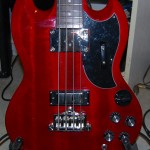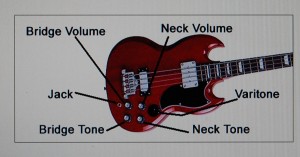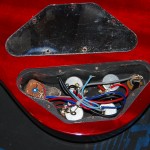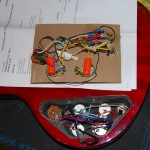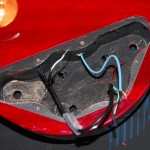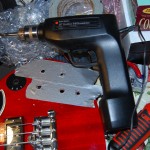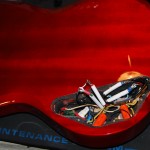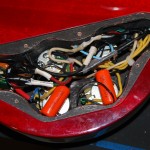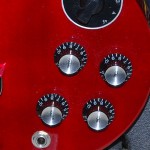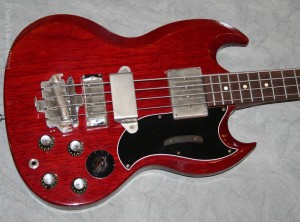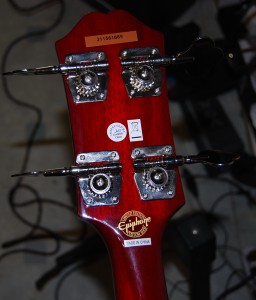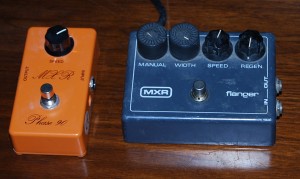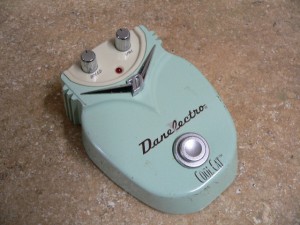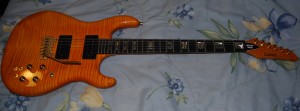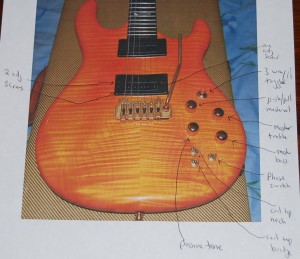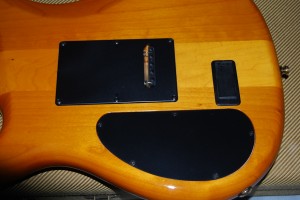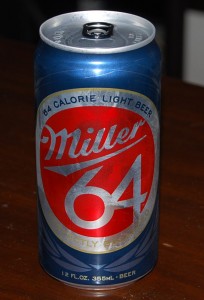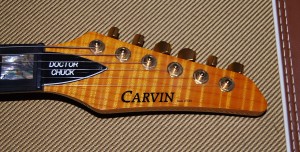Part One: Tone Launch though “varitone”…
Okay, here we go. Next up on 3 easy mods, we’re plugging the new Epiphone EB3 Bass in to my Ampeg B15R (awesome vintage inspired bass amp!) Volume up, tone up. What no varitone? NO VARITONE circuit?!! What?!! ARE YOU %*&$*%#!!! KIDDING ME?!!! And so I discovered that what looked like a varitone was not one at all. Such dastardly wretched duplicity!!! Such deceitfulness!!! A simple chicken head knob with three positions: neck pick up, neck and bridge pickup, bridge pickup. Basically this is the same circuit as on your garden variety toggle switched Les Paul, dressed up to look like a varitone!!!
What a bummer, what a misconception! I felt like I was misled at first, but in reality this basic three piece circuit was staring me in the face. On close inspection of the control plate underneath said chicken head knob were the numbers 1,2,3. That’s it. Right out there in the open, NOT hiding! I just never expected to see them and so I didn’t,.. obviously. All I saw was the preconceived 4 position varitone circuit in my mind and displaced it on to this bass until suddenly the dawn of reality rushed in. Don’t get me wrong, the bass sounded pretty darn good as it was, but to me, it wasn’t an EB3 without a varitone circuit , dig?
So what to do? And so I searched the net for any Gibson EB3 varitone circuit equipped wiring harnesses figuring that there must be some floating around as presented by the host of scavengers who in their vulture like fashion dismantle perfectly good instruments to part them out and sell the guitar parts for a tidy piece by piece profit. Nothing… Ebay had nothing. Nobody had anything except once in a while a choke which is a part of the circuit, would show up. A lot of good a choke is going to do for me, a person who is not about to construct a wiring harness from scratch even though there are schematic diagrams for this control set up available on the net for this purpose.
I kept putting in searches for the circuit varying the theme here and there to see if I could get a different result somehow. Then I came across a very interesting site called Rothstein Guitars: http://www.guitar-mod.com/# They claim that the “cornerstone of their business is their highly regarded prewired assemblies”. I searched through the site but could find nothing that would meet my needs and so I decided to shoot off an email to Andy at Rothstein Guitars to see if they could help me out.
Hi Andy,
I recently bought an Epiphone Custom Shop EB3 bass. I did not realize until I got it that what looks like a varitone is not. The rotary switch is 3 position only and is really simply a rotary pick up selector. Not that this is inherently a bad thing and it does work as expected, but I was hoping that this bass had the four position varitone circuit which it does not. I guess this was done simply to mimic the look while keeping costs down.
Anyway, I came across your site and was hoping for an “Ahaaaa!!” moment but did not find what I was looking for. By any chance would you make a pre wired Gibson EB3 varitone circuit assembly that I could install in this bass or know where I might find such an assembly?
Thank you very much.
Very Sincerely,
Chuck
With my last ditch effort to upgrade this bass to the way it is supposed to be I patiently waited for a response………….. A few days later I checked my email inbox and there it is! An email from Andy at Rothstein guitars!!!
Chuck –
We have had quite a few people ask us for wiring harnesses for EB-3 so we have been planning on offering some mods. We manufacture our own varitone (Platinum Lab Varitone) that is 6 positions (5 filters and a true bypass). http://www.guitar-mod.com/Merchant2/merchant.mvc?Screen=PROD&Product_Code=V6B&Category_Code=MID We could certainly wire up a harness that has 2 independent volume and tone pots, as well as a master varitone. There would of course be no method of pickup selection, except by lowering the volume of which ever pickup you want to shut off.
Regards,
Andy
I got back to Andy to let him know that I liked what he had to say and wanted to proceed with designing this.
Hi Andy,
That sounds great! And as far as your statement; (There would of course be no method of pickup selection, except by lowering the volume of which ever pickup you want to shut off ) that wouldn’t be a problem as my ’62 reissue Fender jazz bass has the same situation and it never bothered me. I do like the fact that it would be wired and ready and that it is inherently superior with 5 selections and true bypass. If you could get back to me with regards to pricing and shipping I would greatly appreciated it.
Thanks,
Chuck
Bingo!!! And so Andy and I went back and forth a bit on the design layout for this circuit until we decided what worked best. In the meantime a seller on Ebay that I inquired to about the same thing finally got back to me telling me that he could faithfully replicate the 4 position varitone circuit as was used on the Gibson EB3 but by this time I was totally stoked with the Rothstein 6 position design which I thought was a far superior approach and so I stuck with it. I know what you are thinking; “He’s deviating from the original design!!” Look, this bass will never really be a replication of the Gibson EB3 anyway as it says Epiphone on the headstock, yes? Not that I have a problem with that as previously discussed in my last post; Gibson EB3 Bass. “CREAM” of the crop. Why you need one! Even the Epiphone Elite which is as close to original as you can get will, like this one, only be technically considered a “tribute” instrument. Okay, so who really cares about this semantic game? As it is so poignantly said at times like this; “it is what it is”; let us move on……
I sent Andy the pre requisite $150.00 plus shipping and then anxiously waited for delivery of my new 6 position varitone circuit equipped wiring harness.
Okay! A few weeks later it finally arrives!! I open the package and there it is totally laid out and labeled on a piece of cardboard ready for drop in installation. I guess this is the equivalent of a heart transplant for an electric bass and it is time to get the patient prepped for surgery.
First thing is to lie it on my rubber guitar mat face up. I remove the knobs and the all mounting hardware from the existing wiring harness. Next flip the bass, open and remove the control panel cover, de solder the pickup connections, ground wire, and make a note of what goes where for future reference. Okay, next is to lift out the wiring harness leaving a stark bare control cavity awaiting its new heart.
You know how they say that things don’t always go as expected? Well, one thing I didn’t anticipate was that the potentiometerswould be so heavy duty and therefore with a larger girth on the Rothstein harness that they would not fit through the existing holes. Time to get the drill out! Talk about heart transplant! Now this is getting as serious as a heart attack to me!
The wood in this area is so thin that it could easily split and shatter should the drill bit “grab” the wood. Looking back, I think I could have slowly and methodically filed the holes to a larger size, but at that time in my excitement and rush to get the install done, it never dawned on me to employ this safer approach. What I did do for precaution was to tape off the areas to at least give the wood some reinforcement. Okay, I sized up the drill bit to match the potentiometer took, a deep breath, and drilled out four holes. Exhale!!! …..Went smooth as silk. Whew!! Luckily the varitone switch and output jack fit with no alteration.
Next, I dropped in the new “heart”. Just made it!! If those potentiometers were any wider I would have had to enlarge the control cavity. It was that close. I then reattached the pickups and the ground wire.
I had to sort of press and fit the wiring as the control cavity was now pretty much filled to the max with wiring “business”.
Screw the control cavity cover plate back on, flip the bass over, mount the pots, knobs, and chicken head varitone knob and we’re set for a test run.
Once again plug into my Ampeg B15R and power up. Nice!!!! Clear, deep, middy full, versatile, are some of the adjectives that immediately come to mind. Okay so here is the basic theme to the varitone. Position One is quite trebly and can actually do a good approximation of a Chris Squire Rickenbacker Bass; clean and deep but also with just a bit of EB3 darkness thrown in. From there as you progress through to position 5 the treble slightly attenuates and the midrange becomes accentuated. Position 5 gives you considerable “bark” and it is so satisfying it might make even Jack Bruce smile!! Position 6 is true bypass meaning that as the varitone circuit is disengaged, there is no defaulting coloration to the bypassed tone. In bypass, it is as if the varitone circuit was never installed.
Bear in mind that with this circuit, even tiny adjustments to the volume and tone mix can yield some very unique tonal differences and because you decide what pickups you want on with the volume control you can even varitone a single pickup, or any combination of both pickups together. The tonal possibilities are quite endless!!
All in all, I could not have been happier with how things came out despite it added another $150.00 to the price of admission.
Next up, Part 2; bridge replacement.
Today’s topic. Gibson EB3 Bass. “CREAM of the crop. Why you need one! Hey, I am child of the 60’s and 70’s. Gimme a break, okay?! I have always loved the Gibson EB3 bass. Well, at least from the first time I was blown away by Cream. Jack Bruce played bass unlike anybody I had seen before. Not just a blur of nondescript deepness to give some bottom end to a band’s sound, Mr. Bruce was quite articulate, lyrical, and definitely expressed himself with clarity and authority. Sometimes it seemed like he was a frustrated lead guitarist but in a great way, who was competing with and battling with Eric Clapton for the helmsmen position of the band. Jack Bruce would weave his bass lines into his own underlying story behind a song and would counterpoint Eric Clapton’s power chording and soloing at the same time. This put a very satisfying tension into the final product which became their trademark band sound and literally established over night, the 3 piece power trio as a viable recipe for a successful rock band, defined the significance of a singing bass player; no easy feat, and further show cased Cream as a very new and unique force to be reckoned with the likes of which we never heard before and arguably since. This band really put the 3 piece format on the map, the limited success of Blue Cheer not withstanding. I had previously thought that a three piece band no matter what, would sound lacking. What are you kidding me? Cream totally rocked and tore down every venue where they performed. Most honorable mention also to The Jimi Hendrix Experience, Led Zeppelin, 3 piece with a lead singer, and Grand Funk Railroad, Rush, Police; also with singing bass player, Sting, and the list goes on. Nevertheless, Cream, for me, was the band that opened up the existence and gave major significance of the 3 piece band concept to me, and with an explosion of sound! Cream seemed to me to be a very appropriate name as they were arguably the top of the heap and henceforth the “CREAM” of the crop of the three piece genre.
BTW, ever try singing lead and playing bass at the same time? Try it and you will see what I mean when I say; “no easy feat”. Yet, since I first witnessed Sir Paul effortlessly doing just this thing, I was captivated by it. Sort of like the split brain piano thing, but different. Of course we can take that to Good Gestalt; give a microphone to Joey Defrancecso and strap a harmonica on his collar as he right and left hands the Hammond B3, plays bass with his left foot, and mans the expression pedal with his right, whew!!,..but that just might veer us off topic, and so maybe we”l hit that up in another rant at some point in the future. Joey could really host a 2 piece power band; B3 and a drummer! Then again if we gave Mr. Clapton a set of bass pedals back in the day, we might not be having to this discussion. Sheesh!!…Aw heck, Cream would NEVER be the same without Jack Bruce on his EB3, right?!!! Gotta love the Gibson EB3 Bass. And so it is time for a rant!
Gibson EB3 Bass. “CREAM” of the crop. Why you need one! Why you need deep thump!
And so as much as I am a fan of Clapton’s “woman tone”, I am equally enthralled by Jack Bruces fat, clear, and ripping bass tone as well. And how did he get this sound? The Gibson EB3 became the instrument of choice for his sonic onslaught. Chcek out; http://www2.gibson.com/News-Lifestyle/Features/en-us/cream-jack-bruce-eb-3-bass-player-0514-2012.aspx The so called “mudbucker’ pick up at the neck supplied the pounding deep thump and the treble pickup at the bridge supplied the clarity and definition that made Bruce’s bass lines cut though the mix with the authority of a lead guitar solo. The EB3 bass had that certain deep, twangy thump to it and I suspect the short scale had a bit to do with it by giving the strings just a touch more elasticity than a long scale bass. Perhaps’s it was due more to Jack Bruce’s style, but in any case, to me this bass was the best and perfect bass for Cream’s unique sound.
Gibson EB3 Bass. “CREAM” of the crop. Why you need one! Controlling your tone:
The controls are at first pretty straight forward. 2Volumes, 2 Tones. Then instead of the standard toggle switch for selecting pickup combinations, there was a 4 position varitone that would roll off some tones and concentrate others. You could be deep and thunderous, also hard hitting with treble clarity, or dial in tons of mid range bark to your soild foundation which what I loved about Jack Bruce’s Cream sound. this was a passive system meaning no battery powering it, but obviously very effective. For further EB3 history check; http://en.wikipedia.org/wiki/Gibson_EB-3
So here I am years later Jonesing for an EB3 bass only to get sticker shock when I start to scan Ebay and the ads in Vintage Guitar etc. Sure there are bargains available, but they are either beat up or circa 70’s editions which I am not at all fond us as they deviate from the original format of what this bass is all about, at least to me. Abbreviated body contours, the neck pick up moved more towards the bridge, and that dreadful slotted headstock. What’s up with that?! This is neither a classical guitar nor an upright bass feh cryin’ out loud! This a rock bass! Also they had a working formula, why screw with it? Okay so then there is the newer SG bass. Icks-nay! No varitone. Look I’m sure it is a wonderful instrument. The varitone is a line in the sand for me. And the obvious choice now would be an Epiphone Elite. What’s that? The name on the headstock is different, you say? Okay then back to square one emptying your bank account to get one, especially if it is one of the earliest models with the spread out volume and tone knobs like Mr. Bruce used, or just get over it! Problem with the Elite models was they seldom come along and I really did not want to wait. I could consider the standard Epiphone EB3 but it is long scale and has trapezoidal inlays. No way. I always loved even the compact look of the short scale EB3. That was the way it is supposed to be. And so I figured I’d just have to wait and see what come along. After all I am not a gigging bassist at the moment so I really can’t justify any urgency. I just want it damn it!
Refurb
And so a few weeks go by and I spot something on Ebay that really grabs my eye. It is an EB3 bass, short scale, with dot inlays, what looks like varitone with the chicken head knob etc. More about that later. So far so good! The headstock says Epiphone, but the only short scale EB3 I’ve ever seen was the aforementioned Epiphone Elite offering. Hmmm. And so I start to read the description. Apparently this was one of those refurbs where they get the guitar from the manufacturer, “refurbish” it, lose the original serial number, replace it with a new one, and sell it as a refurb, no manufacturers warranty/you’e on your own pal! Sometimes they even stamp a “2” on it as well; sort of like “Scarlet Letter” of musical instruments which designates that it has at least one flaw. Yet,the more I looked at this bass in the photos, the more I liked it. I mean, it even had my beloved deep scarfed contours around those devilish bass and treble horns. Damned that if they didn’t nail the body shape of the original, it was darn close indeed. The price was also right at $299.00. Look when you buy one of these refurb instruments obviously you are not looking for a blue chip investment okay? You are looking for the best representation of what you want with nice sound and playability without laying out breaking the bank. Apparently this rendition of the EB3 bass was intended for sale in Japan only and that is why you might never see one of these without the refurbished pedigree,…. or lack thereof.
Pristine vs. Relic
Another thing I liked was that it was brand new and beautiful. I like my instruments new and pristine. I am not at all a fan of beat up instruments whether it is genuine old mojo or new so called “distressed”or “relic” ized. New and shiny my friends, and I really endeavor to keep them that way. All things considered, if I am going to own a beat up guitar with considerable wear, in my world it will be because EYE am the one who caused it, yeah?! And to pay extra to have someone beat it up for me in order to simulate years of wear and tear? Preposterous! Hey you may like guitars with the paint purposely worn off or the hardware purposely tarnished and rusted, or to have your guitar worn and beat to look exactly like your favorite performer with wear marks, scratches, and dings perfectly replicated. Fine, I can accept that . To each his or hers own, I suppose. Just not for me. New and shiny. Did I say new and shiny? Also clean. Yes, to me a clean instrument like a clean car just performs better. Don’t ask me why, just take my word for it. Go polish your guitar and wash your car. Shiny and clean is very good! Your instrument will sound better, and your car will run smoother. Yes.
And so I took the plunge and hit the buy it now. Of course add another $89.95 for an Epiphone hard shell case. If you want to keep your axe in mint shape, a hard shell case is a must. Still all in all a relative bargain.
About a week later the bass arrives ahead of the case. No biggie. I’ll carfully store it in the shipping box until the case arrives. And so with great anticipation I unwrap the bass and give it the raised eye brow scrutinizing inspection. Simply beautiful. I can’t find a flaw anywhere. Deep cherry with nice grain just like its uptown Gibson cousin. Clean and shiny. The beautifully scarfed contours look even better in person. Okay so the headstock doesn’t say Gibson and it is a bit elongated in comparison to the Gibson headstock. T o me being a life time fan of Epiphone remembering the glory days when they were made in the same factory as Gibson, I never had any bias towards the brand and loved the name and logo etc. Yep, not a Gibson in name, but a beautifully inlaid and executed headstock over all. Nice period perfect elephant ear tuners add to the vintage Gibson,… er, Epiphone vibe.
I tune her up and off the bat the action is simply awful. No surprise. I’ve never purchased a guitar that I liked the action on the mark right off the bat and some, like Martin acoustics, can arrive downright finger slicingly high to the touch and in my book, totally unacceptable. Yep, this baby was definite;y going to need a set up, just not tonight. Tonight is just for checking out the bass, evaluating it and deciding what has to be done to make it totally kick ass. In any case, the build quality overall looks excellent, the fret board looks like a nice slab of rosewood and the finish is beautiful, No orange peel or paint drips to be found. Just beautiful. The scale length is right on target, the balance of the bass is really nice and the weight seems just right. Knock on the body and it has a nice ring to it. Acoustically the bass sounds bright and clear.
First impressions in summary:
Got the bass. It has it’s pluses and minuses and the pluses GREATLY out weight the minuses, which is a good thing.
On the plus side:
1) Scarfing or Body Contours are deep, correct and satisfying.
2) Build quality for the ridiculous low price is outstanding.
3) Required minimal set up to get very low action with no buzzing.
4) Cherry Color is deep, rich, and Gibson correct.
5) Pickups are loud, deep, and clear.
6) Tuners are vintage correct tributes and hold tune perfectly.
7) Intonation acceptable if not perfect out of the box.
8) Bridge somewhat adjustable.
9) Fit and finish is outstanding. No lacquer drips, orange peel, overspray or underspray. Excellent gloss.
10) Fret dressing is excellent. No sharp edges when you run your hand up and down the neck which is
typical in this price range.
11) Epiphone mother of pearl logo headstock inlay as well as the Gibson crown inlay excellently done.
12) Set neck heel joint which is ridiculous in itself at this entry level price is as precise and as aesthetic as on
my $4000.00 Gibson Les Paul/SG Custom.
13) Rear Body cavity electronics access cavities are excellently cut. The body covers fit perfectly with
Very uniform “gappage” surrounding.
14) Overall, looks, feels, and almost sounds * like it’s up town and more expensive Gibson cousins.
On the minus side:
1) No case included. At this price, no surprise.
2) The pick guard does not have the vintage WIDE bevel that I love. Well neither does the
current Gibson SG Bass.
3) No chrome hand rest cover later relocated to a bridge pick up cover. Again, the current
Gibson SG Bass lacks this as well.
4) * Most importantly and MOST disappointing at least to me, NO VARITONE. The bean counters
at Gibson did a good job at baiting and switching on this one. What looks like a varitone set up is simply
a standard 2 pickup arrangement disguised as a varitone circuit. Instead of having a 3 position toggle
switch as on the normal typical 2 pickup Gibson, they used a three position rotary switch instead
to accomplish the same thing while looking VERY “varitonish”. Pretty slick those Gibson bean counting so and sos!!
I did not notice this until I got the bass. Then I went back and checked again. All Gibson EB3 basses have
Varitone, as also does the Japanese Custom Shop Epiphone Elite/Elitest EB3; evidenced by the
FOUR!! Position rotary switch. As it turns out, with the exception of the Elite/Elitest line all Epiphone EB3
basses short or long scale have this duplicitous but subtle 3 position rotary switch arrangement.
What to do?
1) I bought the appropriate Epiphone hard shell case. A no brainer but was a bit difficult to find.
2) I am having a custom made wide bevel pick guard fabricated.
3) Found a cover.
4) After much research and interchange with Rothstein Guitars I am having them build me a
custom made replacement wiring harness with a better than original varitone circuit. Why better?
The original has 4 positions. This one will have 6 and with superior EQ presets than the original;
i.e. 5 tone variations with position 6 being true bypass.
That should get this bass exactly where I want it and STILL be a great deal.
Next up, time to plug in and ‘er it rip.
Please stand by………
To see Jack Bruce “rip it up!” with his Gibson EB3 bass, click on the following link of Cream playing Whit Room:
For some interesting further reading on Gibson basses:
http://www2.gibson.com/News-Lifestyle/Features/en-us/gibson-basses-0705-2011.aspx
Some of my best friends still insist on going straight in; guitar, guitar cord, amp. While there is a lot to be said for this purist approach I still believe there is plenty of room for subtle improvement in simple ways and so I want to make some suggestions and show you how to add depth to your guitar tone. While I also am not a fan of highly processed over saturated guitar tones and lean more towards purism, I have always loved the way the basic tones of one’s playing can be enhanced through great simple effects like phasing, flanging, and chorus.
Long ago one of the first effects in this regard was the venerable MXR Phase 90. When I first played through one it was one of those “Wow!” moments. All of a sudden my flat sounding chords opened up with a new life of sweet, swirling depth. The Phase 90 soon caught on as a must have device as it opened the door to a lot of worthy competition.
The operation of the unit was very simple and therefore appealing. Preset depth to how far out of phase your signal wil be taken and by one rotating knob the speed of the effect was adjusted. That’s it and that’s all you needed. Simple but effective. At the lowest speed, slipping in and out of phase has a pleasant eeriness as your tone slowly goes from full and sweet, to hollowed out of phase and middy. At the other end of the spectrum, full speed gave a very much tremulant effect. Personally I was never a big fan of tremolo and to me this was quite similar. My favorite spot on the dial was between 12 and 2 o’clock. Within those spots I felt was the best and sweetest in phase/ out of phase swirl to be had.
Next up is flanging. Again, I was one of the first on the block to jump on the new MXR 117 flanger. I thought that flanging was simply one of the coolest effects on the planet but up to this time figured it was just a super studio only effect having heard it on records but never live. The MXR 117 did it all for me. Having four adjustment controls meant that you could basically cover phasing, flanging, chorusing, ring modulation, and stationary tone settings within the in phase/ out of phase realm by disengaging the oscillator. This unit had a bit more depth to it than the simple Phase 90 and allowed for one to really get carried away creating chimey ring modulation steel drum like sounds all the way to simulating the doppler like soar of a jet plane. Very cool.
Finally chorusing. When I first heard of this effect, I really did not know what it was. Actually it is like a mixture of phasing and flanging a bit and gives a smooth dreamy ambience to your sound. Chorusing can alter the phase of the signal but the real kick is the detuning effect that really thickens the sound making it very sweet and full. A flanger can be set to give chorusing, but as I said I really like a dedicated chorus for that effect because it gives a very lush sound without excess detuning. The detuning very much simulates the doppler effect produced by a rotating Leslie speaker. The doppler efect simply is that the pitch of a tome drops as the distance between you and the source inceases, and conversely raises as the distance decreases. At slow speed you can have nice creamy ethereal swirl, at fast speed it really can warble. As with phasing and flanging, I am not a big fan of the fast extreme setting which I think has limited applications, but I do like the in between speeds very much.
As we all know there are a plethora of these pedals now on the market, some better than others and of course these effects are also part of many multi effects units. Although I really like the convenience of multi effects in one box; no interconnect cords, batteries, daisy chained wall worts etc., I’ve always felt that a good dedicated single effect is better and has the edge tone wise also usually being more adjustable and tweakable. Multi effects pedals often arbitrarily chain effects into presets that allow only limited adjustments. How many times have you played through a multi effect pedal and land on useless presets like “screaming demons from hell’ which yields a total over processed totally useless sound?
I prefer a simpler approach. A littler overdrive just to give my tone a little bit of fur, a touch of reverb to give some space, and then some judicious use of phasing, flanging, or chorusing. So get yourself one of these pedals, experiment with settings and add some depth to your tone.
Have fun!
Today’s rant: Carvin Guitars: Why you will soon want one!!:
And so it dawned on me that being my welcome photo is one of me playing my Carvin DC400, I figured that I would make Carvin guitars the topic of today’s rant. First off I’d like to say that Carvin guitars are arguably the most highly underrated most excellent instruments on the market and on the planet. I have played more than my fair share of Gibsons, Fenders, PRS’s and what have you and Carvin is right up there with them build quality wise, playability wise, and sound wise. In fact it is my most often chosen “go to” guitar whenever I play out. This guitar is pretty much bullet proof and reliably delivers the goods time after time. A proven dependable work horse of a guitar for sure. It is also gorgeous in my humble opinion.
I cannot tell you how many times I will play the DC 400 out that people either in the audience or fellow musicians will remark how great the tone and clarity of this guitar is. Then usually the next question is; “What brand is it?”. I respond; “Carvin”. The usual follow up to that is; “Never heard of it”, which incredibly does not surprise me at all. Then I get; “A new brand?” I tell them; “Only been around since 1946….”
“Say what? Ya kidding me!”
“Nope, serious as a heart attack!”
After that they remark how much they are impressed and want to check it out etc. And so it goes.
Lowell C. Kiesel established the company in 1946 as the L.C. Kiesel Company. At around 1950 he changed the name to Carvin after his two eldest sons Carson and Gavin and the rest as they say, is history..
And so despite being on the planet for more than a few decades, the reason for its somewhat surprising obscurity is that you won’t see a Carvin guitar hanging off a wall in your local Guitar Center or Sam Ash outside of the occasional find on the used rack. Carvin does not do retail. They are factory direct except for a handful of stores in California.and in these stores you will likewise not see any Gibson or Fender guitars because these are Carvin stores. Their rationale is that by bypassing the middle man, they can sell direct to the customer for a far better price claiming that their guitar would sell for much much more if they were in local music stores. Another thing is that while seeming relatively obscure, there are some accomplished professionals who play these Carvins; Craig Chaquico, Allan Holdsworth, and Joe Walsh just to name a few. Amazingly despite some high profiles using a Carvin as their instrument of choice, these guitars still remain one of America’s best kept secrets it might seem.
There are many things I love about my Carvin besides its quality and beauty. It is a very versatile guitar sporting active and passive circuitry with treble and bass boost AND cut, as well as coil taps for each pick up and an out of phase switch for a nice hollow mid-range boost. And so you can get everything from roaring humbucker tones, to twangy single coil sounds; flip the phase switch and get a Fenderish quack which although it does not get the genuine Knopfleresque in between sounds 2 and 4, does an admirable job of covering many bases without having giving the player a need to switch guitars. The pick ups are really unique as well. They have eleven pole pieces instead of six which Carvin claims eliminates dead spots in between the strings and results in more even volume, especially on string bends where the string usually veers off the pole piece. Also there are three height adjustment screws on the pickup frame; two on the bass side and one on the treble side. This not only allows for height adjustment but also angulation so you can parallel the string path. Pretty neat. How many times do you adjust the height on your Les Paul humbucker and find that the pole piece end of the pickup is angled less than ideally into the body, and you can’t do a darn thing about that ?! Kudos to Carvin for their attention to detail and a simple but effective innovation.
The controls are really cool. Like I said this is an active/passive wiring harness that is activated by a push pull master volume pot where as many guitars with active electronics are ONLY just that and have the battery for power, usually a 9 volt, mounted underneath the pick guard. What happens when the battery dies in the middle of your set? Unless you have a spare guitar, you are fubar-ed my friend for you have to deal with a most cumbersome battery replacement procedure to get the guitar up and running again. This means that in the dark lighting of a club, you are faced with unscrewing all those little pick guard screws to remove the pickguard to gain access to the battery while also making sure you don’t lose any of those pesky little screws rolling around whatever and then ultimately disappearing into the cosmos. Doh!!! If this is a Stratocaster like guitar or say one of those Fernandez guitars with the sustainer system, this probably means you have to also Waaaaaayyy loosen all the strings to be able to gain clearance for sliding that pickguard out. You get the picture.., a technical nightmare under the worst possible conditions. You might be more inclined to say the heck with this and do a Jimi Hendrix like “set da bastid on fire guitar smashing!!!” out of total frustration.
Hmmmm,……Wonder how many Stratocasters Jimi destroyed in his career. Who knows. The only thing I remember was that before each tour he would go to New York City and visit Manny’s and Jimmy’s to pick out about twenty Stratocasters. At that time they were going for about $200.00 or so a piece which by the standard of those times was still not cheap. Anyway because left handed Strats were about as rare as hen’s teeth, his tech would then take these twenty or so Strats, change the nuts and bridge saddles to left handed and then restring them up for Jimmy. Wonder what those Strats would be worth now if instead, Jimi simply retired them after a tour without smashing and burning them. Then again, if there are any existing Strat fragments from his smashed guitars, I wonder what those would claim now….. It was once said that they took the sheets from the beds in the hotels when The Beatles and Elvis would be on tour and cut them up into it inch square pieces and sell them off to the hysterically screaming teenage girls. Wonder what those would be worth now… It was also said that in the heyday of Chuck Berry when there was no such thing as light guage strings he would take a standard set, discard the low E string and then use the A string as the low E and string his 335 all the way up to the B when he would run out of strings. Then he would use a banjo string for the high E string so he could then do his famous chord like string bends with his impromptu “Chuck Berry Lights”……….And so what does this have to do with all things Lowell C. Kiessel? Nothing,… Absolutely NUTTIN!!!!! So let’s get back on topic pronto, yeah?!!!! Sheesh!!!!!!!
Anyway, so here you are freaking out because your battery went dead as your guitar goes totally silent and you can’t decide whether you want to smash your guitar or your head, or BOTH, into nearest wall, or set your guitar on fire before smashing it, or set yourself and your guitar on fire simultaneously and go out in a blaze of glory!!…. Enter the Carvin active/passive system. Ahhhhhhhhhhhhhhh………. . Take a sip from that Miller 64 beer can seated on your amp head. Relief is just a swallow away! You are set in active mode and in the middle of the set suddenly the battery goes dead on your Carvin DC400. So far the scenario is the same. This time though, without missing a beat, you pull out your push pull master volume and INSTANTLY engage the passive circuit; quickly adjust your volume no one being the wiser, and seamlessly continue to play. You finish the song and then you finish the set without a glitch. Then over the break and even in the dim light, you simply and briskly spring open the door to the battery compartment on the back of the guitar, remove the dead battery and replace it with a fresh one, all in just a few seconds. MUCH better!!!Now this is living baby!!! This is HUGE!! Much, much better than a most flame filled demise…Yeah!!!!
Another very cool feature is the Wilkenson tremolo system (also available hard tail ) that allows you to pull notes up as well as down. Dive bombing is a breeze for those of you EVH wannabes and then the return to pitch is predictably spot on not only due to this freely anchored and smoothly floating trem but also due to the Graph Tech graphite bridge, Sperzel locking tuners, and the total absence of string grabbing Fender style string trees to keep the strings tensioned against the nut. Instead Carvin pitches the headstock back fourteen degrees to accomplish the same thing without those dastardly string grabbing string trees.
And so boys and girls what is the weakest part of a tremolo system that is MOST responsible for throwing a guitar out of tune?
Answer: The nut. Yes, the nut! Binding at the nut during those trem excursions grabs the string and holds it at a new position either sharp or flat of origin and the result is it sounds like you don’t know how the heck to tune a guitar! I don’t care how good your trem system is or if you have locking tuners, or how well you play. If your nut binds your strings, you WILL go out of tune the first time you lean on that tremolo bar. And so there are remedies for this. The graph tech bridge is one. Being made of graphite, it actually slightly microscopically delaminates while the string is moving to and fro across the nut during a trem excursion and these little teeny weeny graphite molecules slide around and act as a lubricant to prevent the string from binding. Pretty cool, ayy?
For bridges that are not made of such material, the best thing to do is make sure that your nut is properly cut. This might seem like a no brainer, but I’ll tell you, I have had a couple of Gibson custom shop models that are losers in this regard, most notably my beautiful white Gibson Les Paul SG Custom with the lyre tremolo. Lean into that baby and it is “Out of Tune City” despite the stiff Custom Shop price tag. I had to recut the G, B, and high E slots so that they did not bind and luckily there is this great stuff out called Big Bends Nut Sauce that you can apply to the nut slots. This grayish viscous snotty looking stuff is liquid graphite and a miracle in a bottle which works wonders even of your guitar is not tremolo equipped because even string bends can cause the string to bind in the nut to a new position affecting its pitch. And so if you ever find yourself tuning up your guitar and you hear the strings go “cheenk”, “cheenk”, and then there is a more than expected pitch change, your nut is binding fella! Now go out and get yourself some Big Bends Nut Sauce on the double, ya hear?!!
Now these Carvin guitars are made to order if you like. Pick a model, choose your features and design YOUR guitar. This is exactly what I did with mine.I wanted a Wilkenson trem, active/passive electronics, graph tech nut, and Sperzel locking tuners. I also wanted strap locks but they only offered Dunlop and I wanted Shallers, so I put them on myself. The design on the Shallers is less bulky and I also have them on other guitars which would make the straps interchangeable if I so desired. I went with the stock pickups but they had others available. Other CARVIN pickups that is. Yes, They even wind their own pickups! Cool!
I also wanted flamed vintage yellow. Nebulous looking quilt tops sort of confuse my brain and I’m confused enough most of the time. To me there is nothing like a tight uniform tiger stripe chevron nicely book matched piece of maple angling down from the center. Nice. The guitar is also neck through deigned which I also like. Nice smooth slim heel with great access to even the highest frets. Smooth as slate Ebony fingerboard and abalone block inlays. Sweet! The fingerboard is wide and the neck is slim. To some, it may take some adjusting to. I loved it from the get go, but then again I also loved broccoli rabe the first time as well. The body is made from solid alder which is light weight but tonally quite resonant. The flame maple top gives the guitar much brightness although if you use just the neck pickup in humbucker mode with the tone pot rolled back you can get great Clapton “Woman Tone”. Even just tapping on the guitar unplugged the wood has a nice ring to it! Sort of like when Moe taps on Curly’s head or something like that.
And so it goes, that considering I picked and chose most of the features and sort of designed this guitar for only me, I decided to spring a few dollars for the custom engraved Truss rod cover. I think it was like seven dollars for a cheap piece of plastic but What the heck?!! And so I called it the Carvin DC400 Doctor Chuck model! Hahaha!!! My buddy Dr. Renrick C. Benn who is a local oral surgeon and dental school colleague would probably tell me; “Billera, you beat your own drum and dance to your own music!” in his most inimitable fashion……Well, maybe,… sometimes. Why the heck not? It’s just some harmless fun, and it is my damn guitar right? I can do what I want with it, buddy. Okay?! I’ll kick and smash and set it on fire okay?……………….Never!
Sometimes, I think that part of Carvins name recognition problem is due to the versatility of designing your own instrument. It also might cloud up the distinction of the models just a bit. Think about this. For instance my guitar is a DC400, but being that you can really build one that is quite different depending on the feature you want, it is in a sense then, a different guitar, yet it has the same name designation. When for example you buy a Gibson Les Paul Standard you cannot specify that you want block mother of pearl inlays and an ebony board. If you want those features you will have to choose a Les Paul Custom, right? And so not having the ability to swap and choose features with a Gibson Les Paul actually acts as a mark of distinction between the two models and clarifies their identity. And so where am I going with this? Simply here. It appears that the versatility of building your Carvin to your specifications may act like a double edged sword in terms of actually defining a certain instrument and this may present to the potential buyer as not having a particular model that is just “THIS” and nothing else. Could be why when people ask what my guitar is this is they really don’t have a clue, because the designation DC400 may stand for a group of guitars. Sure there are a lot of Les Pauls, but they all have their own specifications and hence their own names and identities. On the other hand Carvin has been around since 1946, so I just might be simply blowing smoke out my shorts!!! Like what the heck do EYE know?!!! Ya can’t argue with success I suppose and Carvin sure had proven that it has staying power which is a nice thing in this day and age for an American guitar company, indeed!!!
To me this guitar does it all, and if I was to be stranded on an island this would be the guitar I would want. Of course that island would have to have electricity for an amp and for a refrigerator to keep those Miller 64’s cold for me and the ladies. Ladies? What ladies? Did I say ladies?? Well, if ya gonna be stranded and HAVE to choose only one guitar, you should at least be able to dream about the other of barest essential “staples” you would need for survival, yeah?
Alright time to get out of here!!
Until next time, thanks for your indulgence in my rant!
For further reading:
http://www.carvinguitars.com/catalog/guitars/dc400
